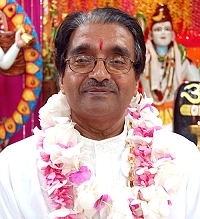From a satsang with Paramacharya of SWAHA, H.H. Pt. Hardeo Persad
In Hinduism, there is the concept of Divine manifestation; there is the belief that God manifests Himself from time to time. Basically, three conditions must exist for the Lord to manifest on earth:
“Whenever unrighteousness (adharma) is on the ascendant, righteousness or dharma is on the decline, and my devotees who depend upon Me, call upon Me for my timely intervention, I manifest from age to age.”
~ Bhagavad Gita
Hinduism also teaches, as in the microcosm (the individual), so in the macrocosm (the universe); (Yatha Pindi, Tatha Brahmandi). Bhagwat Mahaa Puraan states that the Lord has manifested 24 times. This divinity is present in each of us. By the same token, all the demonic forces that exist in the outer world, also exist within us in the forms of negative forces that we must transcend, such as anger, hate, lust, jealousy and so forth. In the macrocosmic sense, when people appeal to that Lord to manifest, He manifests and destroys the adharmic forces. Religious celebrations, such as Raam Naumi, are special occasions when we can appeal to that Lord in a personal manner for his manifestation within us.
There are different types of manifestations. There are Guna Avatars, Vyuha Avatars, Leela Avatars, Ansa Avatars and Kala Avatars. In fact, everyone is a manifestation of the Divine. Aham Brahmasmi, the Vedas proclaim: we are all part manifestation of the Divine. The individual soul is part and parcel of the Supersoul. Thus, when we celebrate special occasions on which the Lord manifests, we should reflect that such a manifestation is also taking place inside, in the sense that we need to transcend the negativities and manifest the positive qualities so that the Ansa Avatar, the Atma (soul) can identify with its true nature, Paramatma.
Our scriptures teach that many thousands of years ago, the earth was in distress, and dharma was in decline. The devotees called out to the Lord for his assistance. It is said on the ninth day in the month of Chaitra, the Divine manifested in human form as Shree Raam.
Who is Shree Raam? Shree Raam is the Supreme Goal to be achieved. To do so, we must be genuinely devoted to the Divine in mind, word and action. Scriptures state that the Divine is known, unknown and beyond the unknown. Raam is, in essence, that Brahm who is beyond even the unknown. He is not just a prince of Ayodhya; He is the Supreme Purusha manifest. As humans, we are conditioned to think in terms of forms and names; we cannot conceptualise that which is formless and nameless. Therefore, the Ultimate Goal is personified in the form of Shree Raam. He is imperceptible, infinite, incomparable and eternal. The Vedas have explained the Divine as “Not this, not that,” such is its vastness and inexpressibleness. Yet the Divine still manifests on earth for the sake of devotees, Mother Earth and the Devtas. The various leelas (plays) over the ages have been documented for the benefit of devotees. By listening to the kathas of Shree Raam, one can free oneself from bondage. These divine stories of the Lord are an aid to us all on our spiritual path of seeking the Divine.



